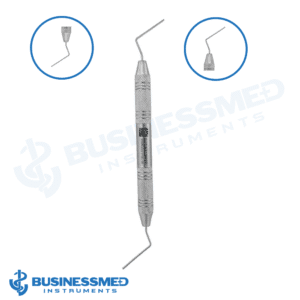Showing all 14 results
Root Canal Pluggers from BusinessMed – Instruments for Precise Gutta‑Percha Condensation
Root canal pluggers are essential endodontic instruments used during the obturation phase of root canal therapy. These precision tools compact gutta-percha using lateral or vertical condensation techniques, ensuring a dense seal that prevents reinfection. BusinessMed Instruments offers a range of high-quality pluggers designed for both anterior and posterior canal anatomies.
Types & Sizes of Endodontic Pluggers
Posterior Plugger Fig. 9 ½ / Fig. 10 / Fig. 11 / Fig. 11 ½ / Fig. 12 – Designed for posterior canals, available in multiple tip diameters to match various canal sizes.
Anterior Plugger Fig. 10 / Fig. 13 – Slim profiles for easy access to anterior canals.
Glick #1 Plugger + Blade – A versatile double-ended tool with a plugger on one side for compaction and a blade on the other for trimming excess gutta-percha.
Available Products:
Key Features to Highlight
Tip Diameter & Shape: Available in various diameters (0.45 mm to 1.10 mm) to suit canal morphology.
Length & Accessibility: Shafts around 21–22 mm allow easy access to posterior regions.
Handle Design: Ergonomic, knurled, or hollow handles ensure comfort and precision.
Material & Sterilization: Manufactured from CE-certified surgical stainless steel, fully autoclavable for long-term use.
Clinical Use Cases
Vertical Condensation: For apical compaction of gutta-percha during obturation.
Lateral Condensation: Slim pluggers assist with spreading gutta-percha laterally along canal walls.
Combination Cutting & Condensation: The Glick #1 allows trimming of excess material while condensing.
Comparison Table
| Plugger Model | Tip Diameter | Use Case | Special Feature |
|---|---|---|---|
| Posterior Plugger 9½ | ≈0.55 mm | Vertical condensation in molars | Slim profile for narrow canals |
| Posterior Plugger 10 | ≈0.60 mm | Posterior obturation | Standard compaction tip |
| Posterior Plugger 11 | ≈0.70 mm | Larger posterior canals | Broad compaction surface |
| Posterior Plugger 11½ | ≈0.75 mm | Deep posterior canals | Extended shaft access |
| Posterior Plugger 12 | ≈0.80 mm | Wide canals | Increased compaction force |
| Root Canal Plugger 13 | ≈1.0 mm | Lateral condensation | Fine control for obturation |
| Glick #1 Plugger | ≈1.1 mm | Multi-step obturation | Dual-ended plugger & blade |
FAQs
Q1. Which plugger is ideal for posterior molars?
Posterior Pluggers Fig. 9½ and Fig. 10 are best suited for narrow to medium molar canals.
Q2. Should I use single-ended or double-ended pluggers?
Single-ended offers size-specific precision, while Glick #1 combines compaction with trimming functionality.
Q3. What is the difference between vertical and lateral condensation?
Vertical compaction seals apically; lateral compaction distributes material along the canal walls.
Q4. Are depth markings necessary for plugger use?
Yes, they help maintain control and avoid overfilling or underfilling.
Q5. How should these instruments be sterilized?
All pluggers from BusinessMed Instruments are fully autoclavable and meet CE quality standards.
Explore Related Endodontic Instruments
Conclusion & Call-to-Action
The right root canal plugger ensures dense filling and long-lasting endodontic success. BusinessMed Instruments provides a full range of pluggers tailored for precision in every obturation case.
👉 Contact Us to request a quote or place your order.














